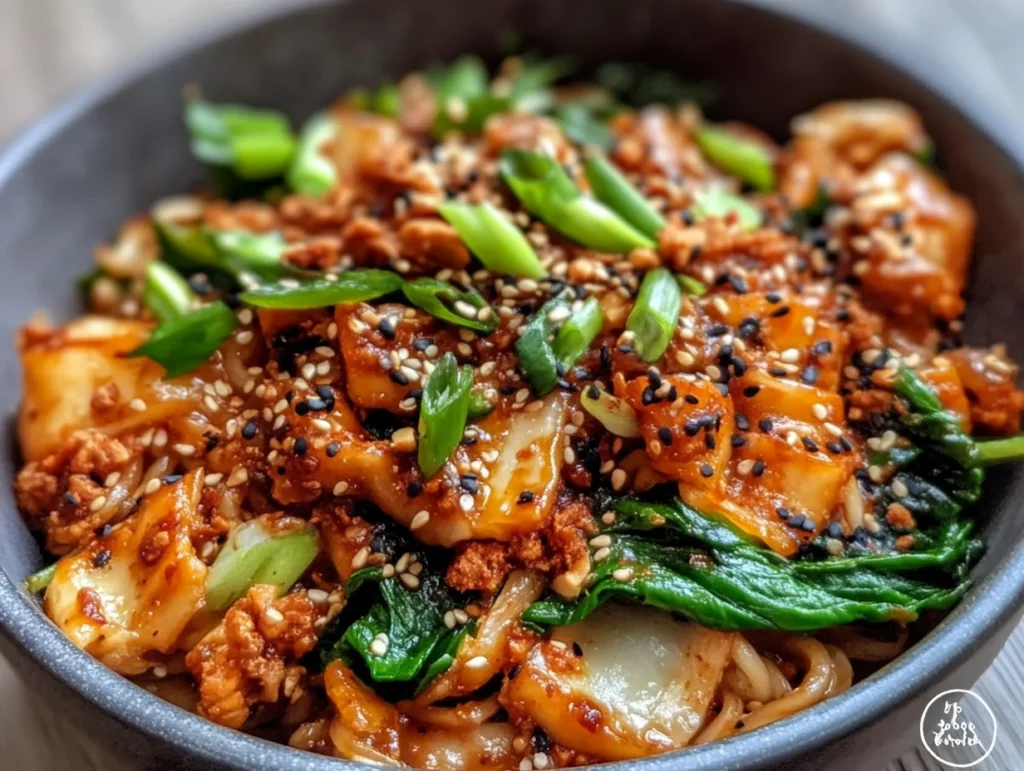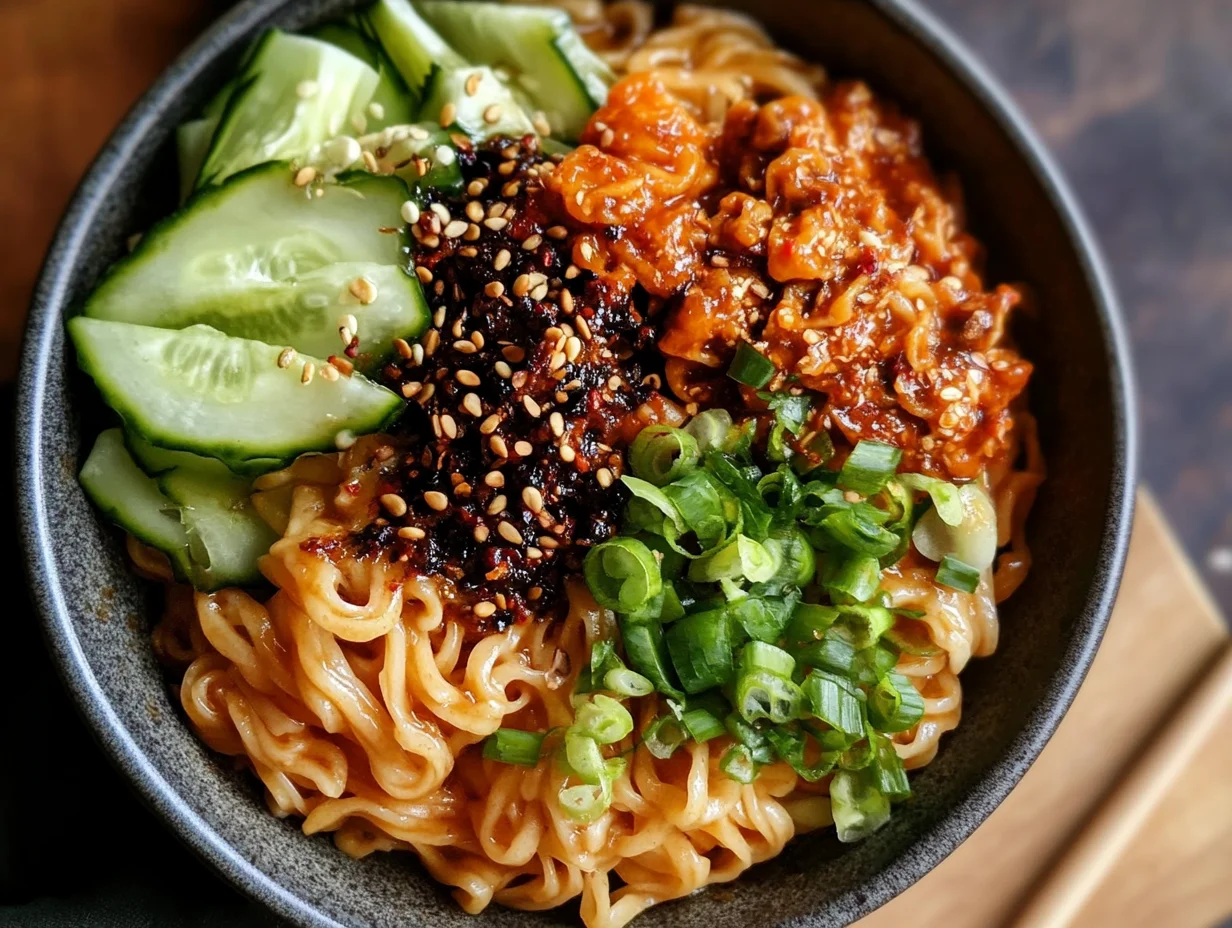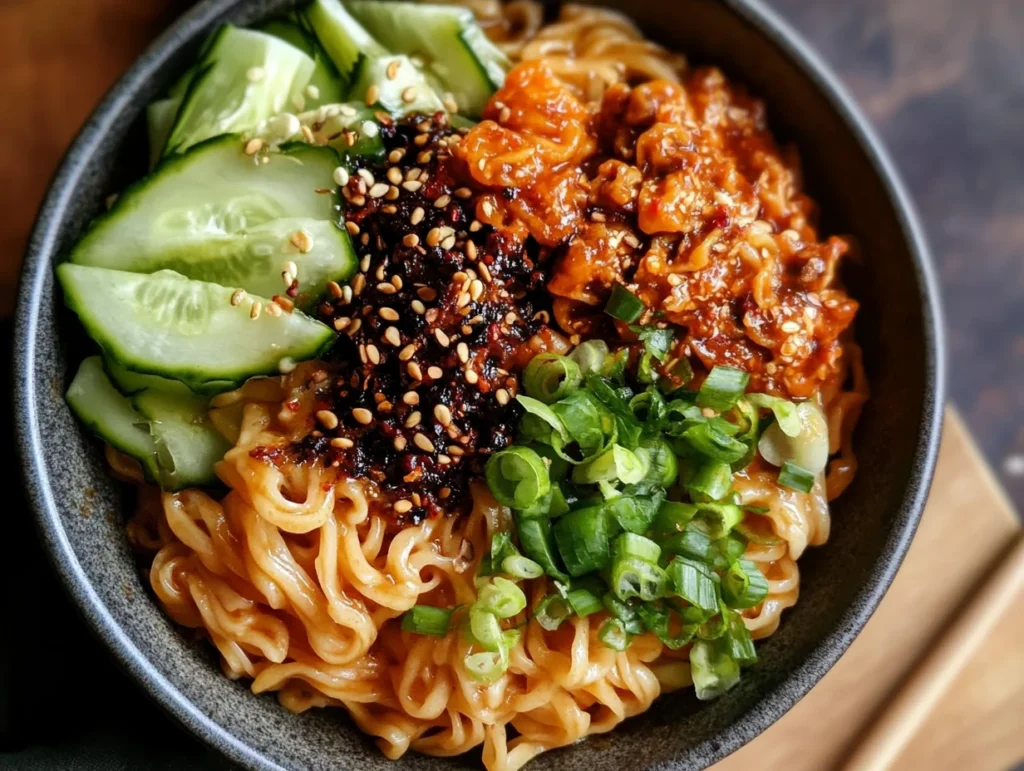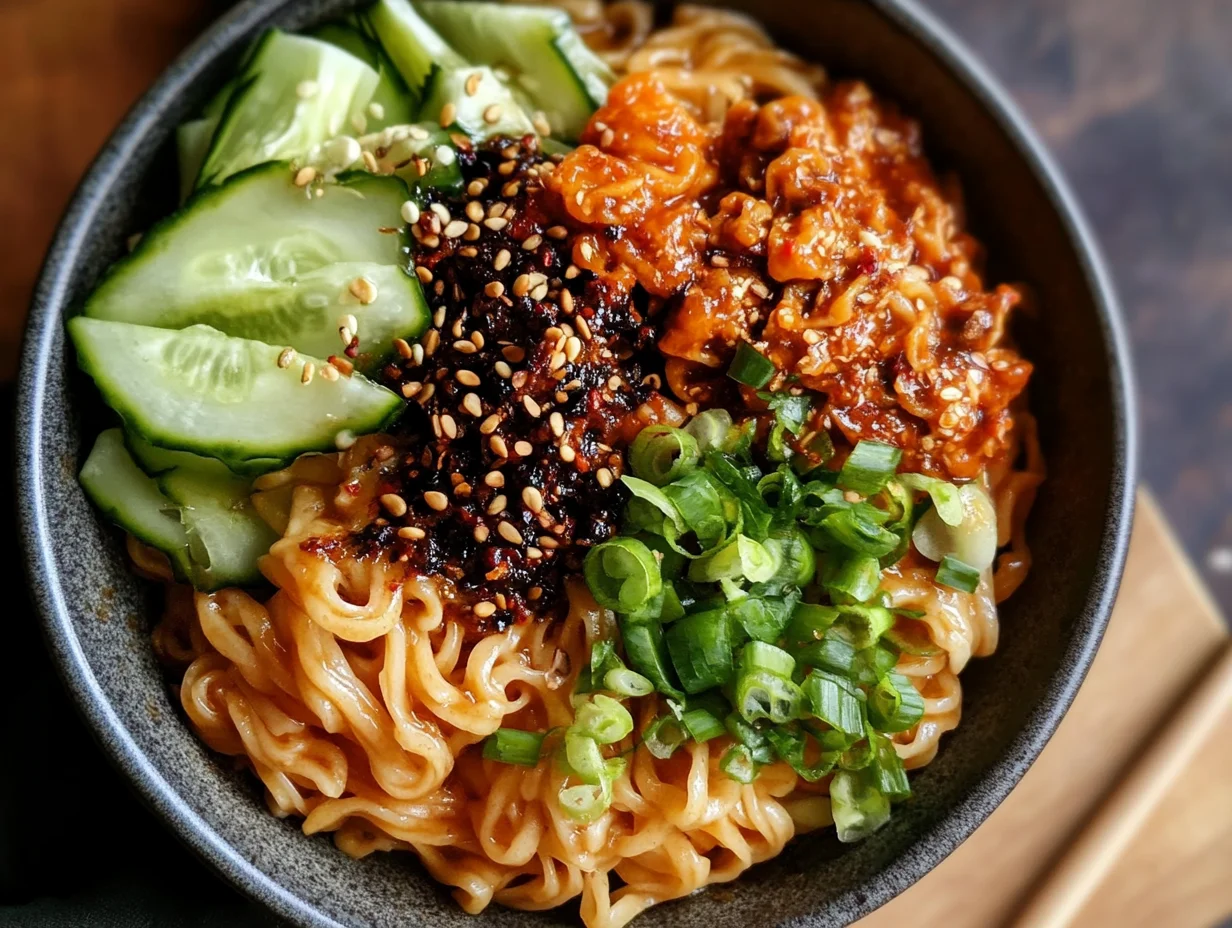Introduction to Peanut Butter Gochujang Noodles
Peanut butter gochujang noodles have emerged as a delightful culinary fusion that captures the essence of both Asian and Western flavors. This dish combines the rich, nutty taste of peanut butter with the spicy, savory kick of gochujang, a popular Korean chili paste. As a result, the noodles create a harmonious blend of flavors that appeal to many palates.In addition, the versatility of this dish makes it suitable for various occasions. Whether you are looking for a quick weeknight dinner or a dish to impress guests, peanut butter gochujang noodles can be adapted to suit your needs. Consequently, this guide will explore the history, key ingredients, and preparation methods, ensuring you can enjoy this mouthwatering dish at home.https://recipesofangels.com/braised-beef-noodle-soup-guide/

Table of Contents
The History of Peanut Butter Gochujang Noodles
Although peanut butter gochujang noodles may seem like a modern invention, their roots can be traced back to traditional Asian cuisine. Specifically, the combination of peanut butter and gochujang reflects the growing trend of culinary fusion. In fact, many chefs worldwide have turned to this combination to create unique dishes that blend cultural influences.Furthermore, the use of gochujang in Korean cooking has a long history, dating back to the 18th century. It was traditionally used as a condiment, adding depth and complexity to various dishes. On the other hand, peanut butter has its origins in South America, where it was first cultivated. Over time, it spread to other cultures, eventually making its way into Asian cuisine.As a result, peanut butter gochujang noodles represent a beautiful intersection of flavors and traditions, showcasing the creativity of modern cooking.
Key Ingredients for Peanut Butter Gochujang Noodles
When making peanut butter gochujang noodles, a few key ingredients are essential to achieving the desired flavor and texture. These ingredients not only contribute to the dish’s overall taste but also provide a satisfying eating experience.
- Noodles: Choose your preferred type, such as rice noodles, udon, or soba noodles.
- Peanut Butter: Opt for smooth or chunky peanut butter, depending on your texture preference.
- Spicy Peanut Noodles
- Gochujang: This Korean chili paste adds a unique spiciness and depth to the dish.
- Soy Sauce: This ingredient enhances the umami flavor, balancing the richness of the peanut butter.
- Garlic: Freshly minced garlic adds aromatic notes and complexity.
- Vegetables: Incorporate a mix of bell peppers, carrots, and scallions for color and crunch.
- Proteins: Consider adding tofu, chicken, or shrimp to make the dish more filling.
By gathering these essential ingredients, you will be well on your way to preparing a delicious peanut butter gochujang noodle dish.
Preparing Peanut Butter Gochujang Noodles: A Step-by-Step Guide
To prepare peanut butter gochujang noodles, follow this simple step-by-step guide. By breaking the process down into manageable steps, you’ll find it easy to create this flavorful dish at home.
- Cook the Noodles: Start by boiling a pot of water. Once boiling, add your chosen noodles and cook according to the package instructions. Ensure that they reach the desired tenderness, then drain and set aside.
- Prepare the Sauce: In a bowl, combine peanut butter, gochujang, soy sauce, and minced garlic. Whisk the ingredients together until you achieve a smooth, cohesive sauce. If necessary, add a splash of warm water to thin it out.
- Sauté the Vegetables: In a large skillet, heat a tablespoon of oil over medium heat. Add your selected vegetables and sauté until they become tender and slightly caramelized. This step enhances their natural flavors.
- Combine Ingredients: Add the cooked noodles to the skillet, then pour the prepared sauce over the noodles and vegetables. Toss everything together, ensuring that the noodles are evenly coated with the sauce.
- Add Proteins (Optional): If you want to include proteins, now is the time to add them. Stir well to ensure they are heated through and coated in sauce.
- Serve and Enjoy: Once everything is well combined, remove the skillet from heat. Serve the peanut butter gochujang noodles hot, garnished with additional scallions or sesame seeds if desired.
Following these steps will lead you to a delectable dish that showcases the fantastic flavors of peanut butter and gochujang.

Tips for the Perfect Peanut Butter Gochujang Noodles
To elevate your peanut butter gochujang noodles, consider implementing several helpful tips. By keeping these suggestions in mind, you can create a dish that not only tastes great but also impresses your guests.
- Adjust the Spice Level: If you prefer a milder dish, reduce the amount of gochujang or add a bit of sugar to balance the heat. Conversely, if you enjoy spicy flavors, feel free to increase the gochujang or add red pepper flakes.
- Experiment with Ingredients: Don’t hesitate to modify the recipe based on your preferences. For example, you can substitute vegetables or proteins as desired, ensuring the dish meets your taste.
- Incorporate Fresh Herbs: Adding fresh herbs such as cilantro or basil can enhance the overall flavor profile and provide a refreshing contrast to the richness of the sauce.
- Serve with Lime: A squeeze of fresh lime juice over the finished dish can brighten the flavors and add a zesty touch.
By following these tips, your peanut butter gochujang noodles will be perfectly balanced and bursting with flavor.
Popular Variations of Peanut Butter Gochujang Noodles
Peanut butter gochujang noodles can be customized in numerous ways, allowing for a variety of delicious variations. Here are some popular adaptations to consider:
- Vegetarian Version: Replace any meat with tofu or tempeh for a hearty vegetarian option. Additionally, include more vegetables like broccoli or snap peas.
- Spicy Peanut Butter Gochujang Noodles: For those who love heat, add extra gochujang, chili oil, or even sriracha to the sauce for a fiery kick.
- Creamy Peanut Butter Gochujang Noodles: To create an even creamier sauce, mix in a splash of coconut milk or heavy cream. This addition provides a rich, velvety texture.
- Cold Noodle Salad: For a refreshing twist, serve the peanut butter gochujang noodles cold. Simply chill the cooked noodles and toss them with the sauce and vegetables. This variation is perfect for hot summer days.
These variations showcase the versatility of peanut butter gochujang noodles, making them suitable for any occasion.
Serving Suggestions for Peanut Butter Gochujang Noodles
When it comes to serving peanut butter gochujang noodles, presentation plays a crucial role in enhancing the overall dining experience. Here are some suggestions to elevate your serving style:
- Garnish with Fresh Herbs: Add a sprinkle of chopped cilantro or green onions on top of the noodles for a pop of color and freshness.
- Include a Side Salad: Pair the dish with a light side salad made of mixed greens and a simple vinaigrette. This adds a refreshing contrast to the rich noodles.
- Serve with Pickled Vegetables: Incorporating pickled vegetables, such as carrots or radishes, can provide a tangy crunch that complements the noodles beautifully.
- Offer Extra Sauce: Consider serving additional peanut butter gochujang sauce on the side for those who want to enhance the flavor even more.https://recipesofangels.com/braised-beef-noodle-soup-guide/
By implementing these serving suggestions, you can create a visually appealing and delicious meal.

Nutritional Considerations for Peanut Butter Gochujang Noodles
When preparing peanut butter gochujang noodles, it’s essential to consider the nutritional aspects of the dish. While it offers a delightful combination of flavors, it is also crucial to be mindful of the ingredients used.
- Peanut Butter: While peanut butter is a good source of protein and healthy fats, it is also calorie-dense. Therefore, moderation is key, especially if you’re watching your caloric intake.
- Gochujang: This chili paste contains both spices and sugar. While it adds flavor, be aware of the sugar content if you’re looking for a healthier option. You can choose a low-sugar alternative if desired.
- Noodles: The type of noodles you choose can significantly affect the dish’s nutritional profile. Whole-grain noodles or zucchini noodles can provide more fiber and nutrients compared to traditional white noodles.
- Vegetables: Incorporating a variety of vegetables not only enhances the flavor but also boosts the dish’s overall nutritional value. Aim for colorful vegetables to maximize vitamins and minerals.
By considering these nutritional aspects, you can enjoy peanut butter gochujang noodles while remaining mindful of your dietary needs.
Peanut Butter Gochujang Noodles for Special Occasions
Peanut butter gochujang noodles can be an excellent choice for special occasions, whether a casual gathering or a more formal event. Their unique taste and versatility make them suitable for various settings.
- Dinner Parties: Impress your guests by serving peanut butter gochujang noodles as a main dish. They can be easily paired with appetizers and desserts to create a well-rounded meal.
- Potlucks: This dish is ideal for potluck gatherings, allowing guests to enjoy something different. You can prepare it in advance and serve it warm or at room temperature.
- Celebrations: Consider making peanut butter gochujang noodles for birthdays .
FAQ: Peanut Butter and Gochujang Noodles
Does Gochujang Go with Peanut?
Yes, gochujang pairs exceptionally well with peanut. The spicy, savory notes of gochujang complement the rich, nutty flavor of peanut butter, creating a delicious balance. Many recipes incorporate both ingredients, especially in dishes like peanut butter gochujang noodles, where they enhance each other’s flavors and provide a unique taste experience.
Does Peanut Butter Taste Good in Noodles?
Absolutely! Peanut butter adds a creamy, rich texture and a nutty flavor to noodles. When combined with other ingredients, such as soy sauce and gochujang, it creates a delightful sauce that coats the noodles perfectly. Many people enjoy the combination of flavors, making peanut butter a popular addition to various noodle dishes.
Can I Add Gochujang to Instant Noodles?
Yes, you can definitely add gochujang to instant noodles! This addition enhances the flavor profile, turning a simple meal into a more flavorful dish. Just mix a spoonful of gochujang into the broth or sauce of the instant noodles to achieve a spicy and savory kick. It’s a quick and easy way to elevate your instant noodle experience.
What Does Peanut Butter Do to Ramen?
Adding peanut butter to ramen creates a creamy and rich flavor that complements the traditional broth. It adds depth and a nutty taste, transforming the dish into a more satisfying meal. The combination of unique and delicious sauce that clings to the noodles, making each bite flavorful and enjoyable.
Conclusion: Enjoying Peanut Butter Gochujang Noodles
In conclusion, peanut butter gochujang noodles are a delightful fusion dish that offers a unique blend of flavors and textures. By combining the rich creaminess of peanut butter with the spicy and savory notes of gochujang, this dish has become a favorite among food enthusiasts.Furthermore, the versatility of peanut butter gochujang noodles allows for endless variations, making it suitable for any occasion. Whether you prefer a vegetarian option, a spicy version, or a creamy twist, there is a way to enjoy this dish that caters to your tastes.Moreover, considering the nutritional aspects of the ingredients can help you create a balanced meal that satisfies both your cravings and dietary needs. Serving it with fresh herbs, pickled vegetables, or a side salad can elevate the experience, making it visually appealing and delicious.Ultimately, the joy of preparing and sharing peanut butter gochujang noodles lies in the creativity and flavors that come together in every bite. So, gather your ingredients, follow the steps outlined in this guide, and indulge in the delightful experience of enjoying peanut butter gochujang noodles with family and friends.
